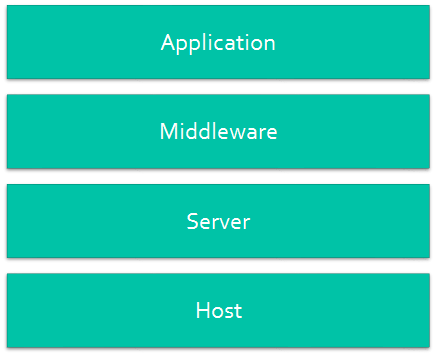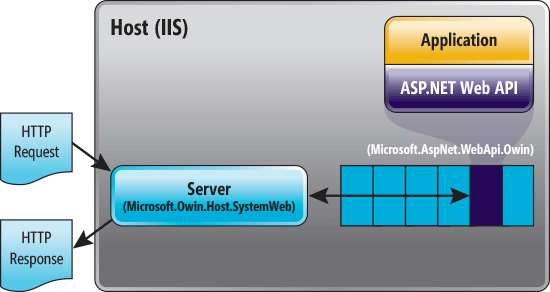实现安全的方式既可以是host提供,也可以框架提供。
1,HTTP Module 方式,工作在IIS上,所以web api要托管在IIS上才行。其作用于HTTP管道的最前端,所以这种方式影响的是全局,对每一个请求都要拦截,因此弹性不足。
2,OWIN Middleware,Owin是新一代Asp.Net Web开发架构,有着非常简单的规范定义,目标是用于解耦Web Server和Web Application.,不再依赖System.Web,Middleware也是属于请求拦截器,类似HTTP Module,会拦截所有的请求,影响全局。其作用于OWIN pipeline(因此需要满足OWIN标准的web服务器支持),Web API 2框架也支持这种方式。中间件的好处是可在不同框架中通用,例如MVC,同时OWIN解耦了web服务器(IIS),因此中间件可以在自托管或者非IIS上使用。当然也支持微软自家的IIS,前提是(IIS-integrated) ASP.NET pipeline。
中间件的注册
using Owin;
public class Startup
{
public void Configuration(IAppBuilder app)
{
app.Use<AuthenticationMiddleware>();
app.Use<CacheMiddleware>();
}
}
要忽略host level的中间件,可以使用如下方法
public static class WebApiConfig { public static void Register(HttpConfiguration config) { // Web API configuration and services // Web API routes config.MapHttpAttributeRoutes(); config.Routes.MapHttpRoute( name: "DefaultApi", routeTemplate: "api/{controller}/{id}", defaults: new { id = RouteParameter.Optional } ); config.SuppressDefaultHostAuthentication();//忽略host默认的认证方式 } }
这里的host其实是一个进程,owin程序的载体,目前有三种(IIS/ASP.NET,Custom Host,OwinHost.exe),Server的作用是open a network socket, listen for requests, and send them through the pipeline of OWIN components specified by the user。目前server有两种实现Microsoft.Owin.Host.SystemWeb和Microsoft.Owin.Host.HttpListener
参考:http://www.asp.net/aspnet/overview/owin-and-katana/an-overview-of-project-katana

owin托管在IIS中(需要Microsoft.Owin.Host.SystemWeb.dll支持)

3,Message Handler方式,前两种都是属于host提供的方式,而Message Handler是web api框架提供的。他不依赖host或者server。但是它的作用粒度还是不够细,只能作用于全局或者特定的路由。

作用范围实例:
public static class WebApiConfig { public static void Register(HttpConfiguration config) { config.Routes.MapHttpRoute( name: "Route1", routeTemplate: "api/{controller}/{id}", defaults: new { id = RouteParameter.Optional } ); config.Routes.MapHttpRoute( name: "Route2", routeTemplate: "api2/{controller}/{id}", defaults: new { id = RouteParameter.Optional }, constraints: null, handler: new MessageHandler2() // per-route message handler,特定路由 ); config.MessageHandlers.Add(new MessageHandler1()); // global message handler,全局 } }
4,Filter方式,这类似MVC过滤器概念。同样是由web api框架提供的,不依赖host或者server,可以作用于全局、控制器、Action级别。
请求顺序是:先经过认证过滤器(authentication filters),再经过授权过滤器(authorization filters)
设计认证过滤器的原则是:仅负责验证凭据(only responsibility of validating the credential)
如果凭证不存在,则忽略(不处理匿名请求),如果存在但是验证失败,则返回unauthorized(context.ErrorResult=UnauthorizedResult)
如果存在并验证通过,则设置context.Principal,这个属性是IPrincipal的实现,是基于角色的的访问控制,而不是Claims-based的

全局作用范围注册方法:
public static void Register(HttpConfiguration config) { config.Routes.MapHttpRoute( name: “DefaultApi”, routeTemplate: “api/{controller}/{id}”, defaults: new { id = RouteParameter.Optional } ); // add global authorization filter config.Filters.Add(new ClaimsAuthorizeAttribute()); }
注意示例中的继承关系
ClaimsAuthorizeAttribute继承自System.Web.Http.AuthorizeAttribute
AuthorizeAttribute继承自System.Web.Http.Filters.AuthorizationFilterAttribute
5,以上几种方式混合使用时,对于IIS,请求管道中顺序如下所示:
